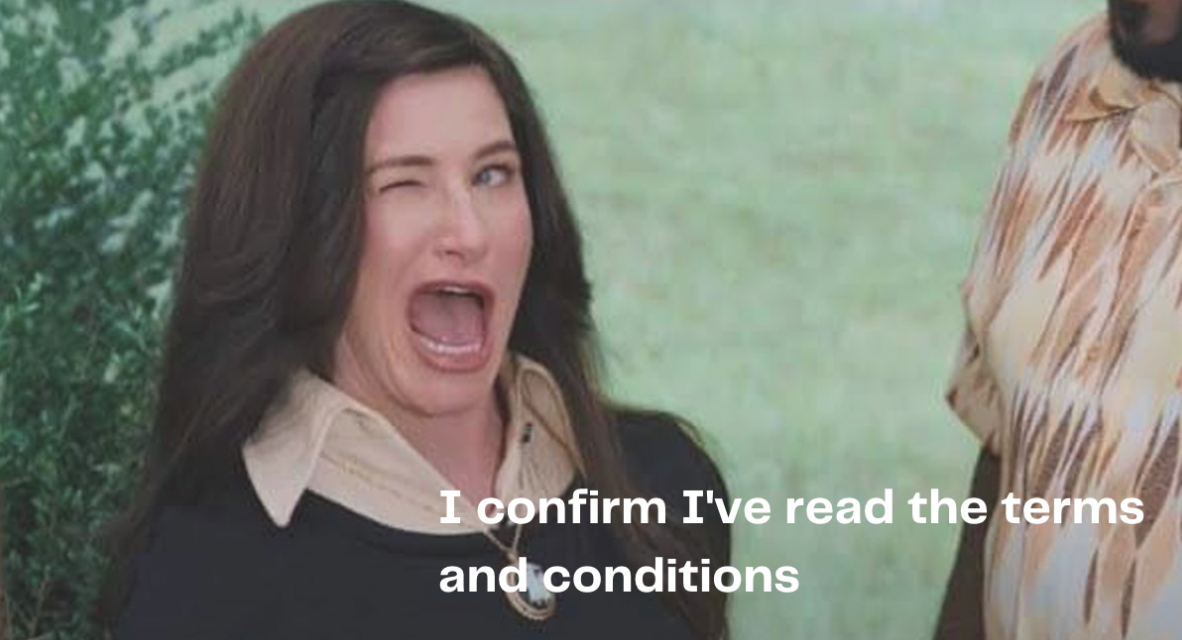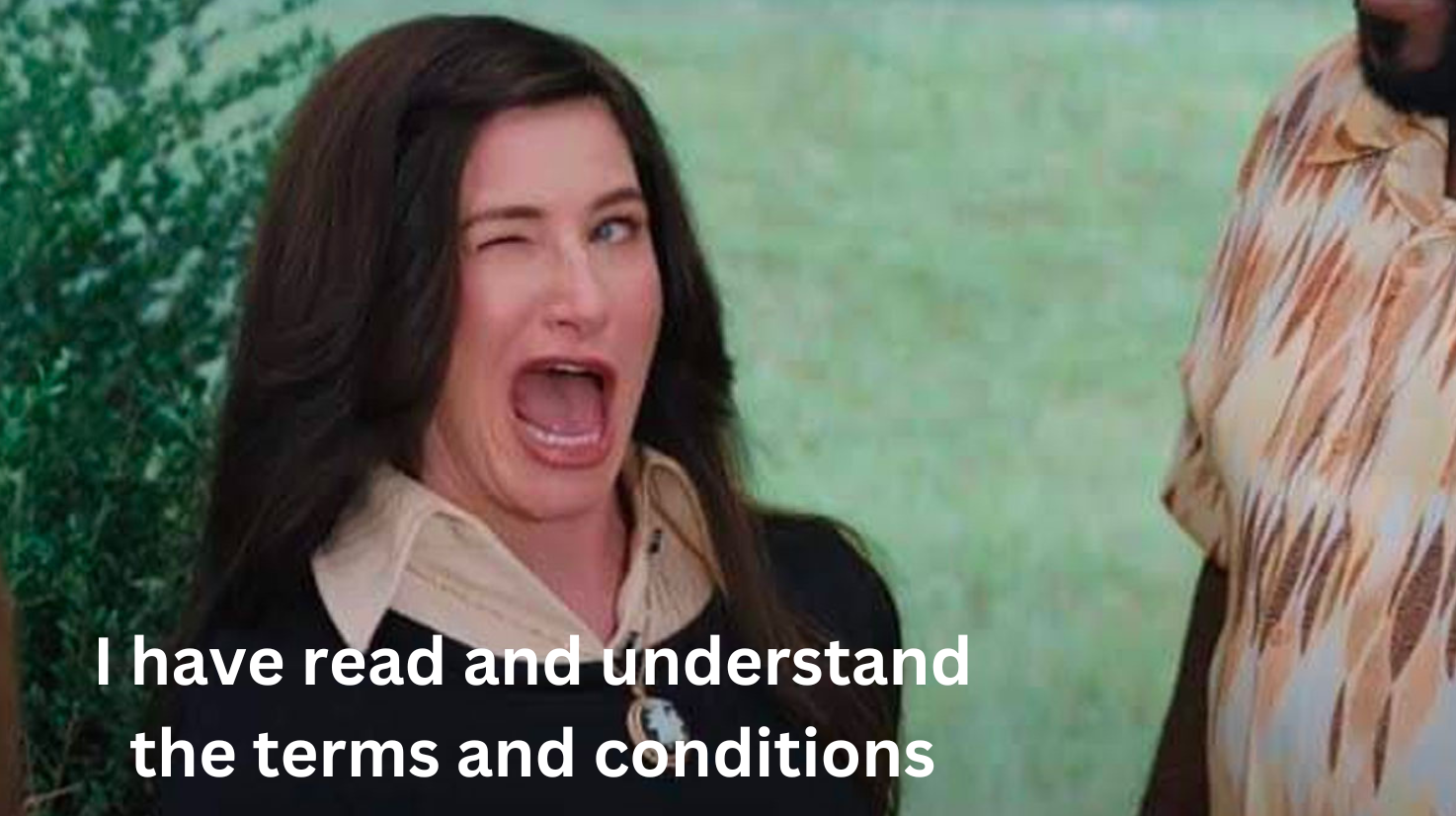When did you last click a box that said ‘I have read the terms and conditions?’
For most people, it is probably no less than a week ago. For some, it’s probably something they do almost every day. I’ve monitored the frequency of my own terms and conditions declarations over the past month and I average approximately 5 per week. Granted, as managing director of a financial services copywriting agency, I am probably at the extreme end of the distribution; I do a lot of free software trials, I subscribe to a lot of newsletters, Substacks and other things where I need to make an agreement with a provider.
Here’s a follow-up question.
When was the last time you told a service provider, by way of ticking a box on their website, that you had read (and possibly agreed to) their terms and conditions, without lying?
Nobody cares about the conditions of carriage until they need to make a claim against the airline or via their insurer, so airlines make it easy for us to say we’ve read and understood them.
If the answer is anything other than ‘I can’t remember’, please email me because we need people like you for user testing.
For most people, the answer is probably somewhere between ‘never’ and ‘when I took out a mortgage’. And even with mortgages, most people do not read the terms and conditions. They read the product summary.
“I have read the terms and conditions” is what two communications professors, Jonathan Obar of York University in Toronto and Anne Oeldorf-Hirsch of the University of Connecticut, call “the biggest lie on the Internet.”
And they proved it. In a study of 543 participants, who thought they were signing up to a student social network, they managed to get 100% of people to consent to give their first-born child to NameDrop, the owners of the fictional social network.
Consumers don’t read the terms and conditions.
The grim reality of terms and conditions declarations
Vendors of all stripes ask their customers to read and in some cases say they consent to their terms and conditions. Once we click that dialogue box, we enter into something resembling a contract. User journeys are designed to stop people from progressing to completion if they haven’t given their expressed consent to the terms and conditions.
However, have you noticed that a lot of vendors, especially software vendors and tech platforms, have started to incorporate user experience functionality into their terms and conditions interactions that help you get to the bottom of the document quicker?
Here we see three options, with the option to open and read the licence situated to the left, away from where the user would naturally hover or tap. This interaction is designed to hurry the user into clicking ‘agree’ without reading what they’re agreeing to.
It’s almost like they know you won’t read the document in full and don’t want that fact to be a barrier to you quickly signing up and consenting. Admittedly, these skip options tend to be most common when the stakes are low, for example when signing up to free web-based services. When the stakes are a bit higher, for example when signing up for things like bank accounts and paid-for services, regulatory compliance stops this shortcut.
Terms and conditions of some popular technology platforms, printed on the ground.
Terms and conditions and the financial services industry
Essential Content recently supported a global investment bank on a content and tone of voice audit. The main objective was to improve overall user experience and make the language more accessible for all users. One particular challenge was the high proportion of ‘legacy’ customers who were still more comfortable using offline processes, and how to manage their migration to digital. It was a fascinating project to work on and we think the new pages serve users extremely well.
One notable aspect of the project was the client’s terms and conditions. The original document we started with had more than 12,000 words. We got that document down to 3,000. For every 4 words, we got rid of 3. And the terms and conditions are still compliant. They still satisfy every single one of the regulatory requirements that the Financial Conduct Authority has set out.
One thing we think we do particularly well as a team is the ‘boring, but important’ stuff. And terms and conditions are perhaps the most ‘boring, but important’ aspects of user experience.
In fact – counterintuitively – we believe that this document is now more compliant than it was before and our client agrees. Cutting 9,000 words from one of the most important documents made it more compliant because it made the document more accessible.
Why are financial services terms and conditions inaccessible?
Big companies, especially regulated businesses and particularly banks, take accessibility seriously. They spend a lot of time and money making sure their digital platforms and documents are accessible. Except when it comes to terms and conditions.
Terms and conditions are inaccessible because they are too long to read. It’s difficult – but not impossible – to write terms and conditions that are user-friendly, accessible and compliant at the same time.
One of the most overlooked aspects of accessibility is what we call likelihood of engagement. If a document is prohibitively long or complex, it is necessarily not an accessible document. Pages, documents, elements or messages that are unappealing by design are inaccessible. People don’t read terms and conditions simply because it would take too long. So they enter into agreements that they don’t fully understand or agree with. And it’s the fault of the bank.
Why are terms and conditions so long?
The simple answer to this is fear of litigation.
Banks don’t produce complex and long terms and conditions because they care about consumers and want to make sure that they have access to every detail, clause, exclusion and limitation that applies to their products and services. They make them that way so they can demonstrate to their regulators and the ombudsman that they did all they could to be compliant. Terms and conditions are written for the benefit of the business, not the customer.
But ironically, this is the exact opposite of what the FCA wants.
What does the Financial Conduct Authority say about terms and conditions?
Since 2016 the FCA has been encouraging banks to make their terms and conditions shorter and easier to understand. They even have a term for what they think banks are doing; ‘over-disclosure’. In a feedback statement entitled ‘Smarter Consumer Communications’, the FCA said:
“One fundamental barrier to improving T&Cs is the over-disclosure approach adopted by firms as a mechanism to mitigate perceived risk of litigation. In our view, we consider this concern should not prevent firms doing more to improve the quality and effectiveness of T&Cs.”
What is over-disclosure?
In plain English, the FCA thinks banks use terms and conditions to cover their own backsides for when things go wrong. They continuously add new clauses and definitions to their terms and conditions without updating the content that already exists.
UK current account terms and conditions
As well as monitoring my own interactions with terms and conditions, the Essential Content research team did some digging to see how banks in the UK handle their own terms and conditions.
Here’s a summary of what our research found.
- The average (mean) current account terms and conditions document is 16907 words long
- The average current account terms and conditions document would take just under 75 minutes to read (you could fly from Manchester to Amsterdam while you’re reading them)
- There is an enormous range in the sizes of UK current account terms and conditions documents. The shortest one we analysed was Monzo’s (4,215 words, still longer than Magna Carta) and the longest was Santander, at more than 34,000.
Read the full financial services copywriting study.
How to write short, user-friendly terms and conditions
As a bare minimum, terms and conditions should meet the following criteria:
Start with the bare minimum and iterate
The reason that terms and conditions cause so many problems is that the content is so dense. You can make your terms and conditions immediately more accessible by starting from scratch and asking yourself as an organisation ‘what does the customer need to understand to make an informed decision about this product?’
Define important terms
It’s unavoidable that your terms and conditions will contain language that requires definition. For example, product names and product features may not be immediately understandable or discernible from other similar products.
If you find yourself defining lots of terms, consider whether the language you are using is sufficiently plain. The best example we’ve come across of needlessly unclear language is how banks handle the concept of ‘money’. Most adults know what money is. But what about remittance? Or funds. As soon as you start using interchangeable terms, such as ‘funds’, ‘liquidity’ or even ‘remittance’ in your content, the amount of people you can address clearly diminishes.
Explain in plain language what the customer is signing up for
Taking current accounts as an example, this would need to cover the following.
- Product features
- Fees and charges
- Exclusions and limitations
Highlight rights and obligations for both parties clearly and unambiguously. Does the customer understand what they are getting, how much it costs and what – if any – factors may cause the price or service to change?
Regarding exclusions, clearly highlight any scenarios in which a reasonable person may expect something to be included when it isn’t. A common example of exclusions would be pre-existing medical conditions on health insurance.
The best way to handle exclusions is to be direct, and state, ‘you cannot use this product / service / benefit if:’ and then present a comprehensive list, separated by topical headers if appropriate.
Don’t make unreasonable demands
A lot of terms, policies and agreements put undue demands on the user. For example, asking them to give consent that they cannot reasonably provide.
Here, Nectar / Sainsbury’s are asking one user to confirm that they and potentially other people have read and agree to comply with their rules and privacy policy.
Terms and conditions don’t need to be complicated. They just need to be clear, concise and consistent.








